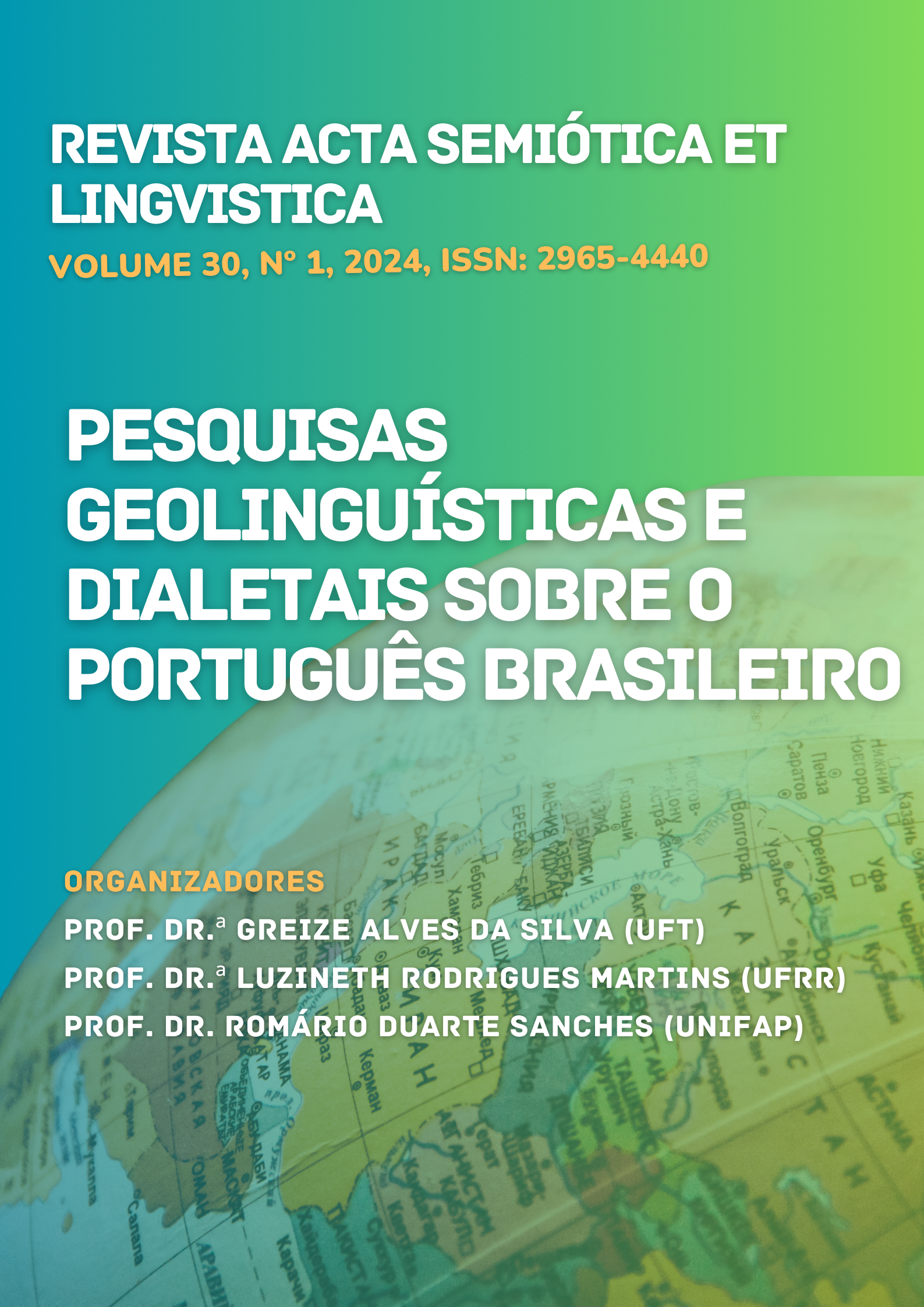THE EYES ARE THE MIRROR OF THE SOUL - LEXICAL-SEMANTIC STUDY OF THE DESIGNATIONS FOR EYELID AND STRABISMUS IN TOCANTINS
RESULTS FROM THE ALITTETO
DOI:
https://doi.org/10.20873/actasemiticaetlingvistica.v30i1.19024Keywords:
Semantic Field of the Human Body, ALiTTETO, Lexical PolymorphismAbstract
The eyes, as an integral part of the five human senses, play an essential role in the visual perception of the world around us; they represent both visual capacity and can encompass perceptions that transcend physical boundaries. Given this socio-cultural importance, the present study analyzed the lexical variants collected by the Topodynamic and Topostatic Linguistic Atlas of the State of Tocantins (ALITTETO) (SILVA, 2018), concerning two inquiries involving the field of 'eyes', collected from 96 informants, stratified by gender, age, and type of mobility. The inquiries are: 069 - What is this part covering the eye called? and 071 - What is the person called who has their eyes turned in different directions? From these, we compared the variants provided as responses by informants based on diatopic and social criteria, and presented the results in dialectal maps elaborated by Geolinguistics criteria. The results point to lexical polymorphism and semantic neologisms, stemming from the combination of linguistic elements and the attribution of new meanings to existing words.
References
AULETE, Caldas. Dicionário contemporâneo da língua portuguesa. Rio de Janeiro: Delta, 1986.
BIBLIA, Bíblia Sagrada. João Ferreira de Almeida. 6ª edição. Santo André – SP: Geográfica Editora, 2021.
CARDOSO, Suzana Alice Marcelino. A Dialectologia no Brasil: perspectivas. D.E.L.T.A., v. 15, n. especial, p. 233-255, 1999. Disponível em: https://periodicos.ufba.br/index.php/estudos/article/view/27601/17187. Acesso em: 13 nov. 2022.
CARDOSO, Suzana Alice Marcelino. Geolinguística: tradição e modernidade. São Paulo: Parábola, 2010.
CARDOSO, Suzana Alice Marcelino; MOTA, Jacyra. Projeto Atlas Linguístico do Brasil: antecedentes e estágio atual. ALFA: Revista de Linguística, São Paulo, v. 56, n. 3, 2012. Disponível em: https://periodicos.fclar.unesp.br/alfa/article/view/4924. Acesso em: 23 mar. 2024.
CHAMBERS, Jack. K.; TRUDGILL, Peter. La Dialetología. Madrid: Visor Libros SL, 1994.
CUNHA, Antônio Geraldo da. Dicionário etimológico da Língua Portuguesa. 4. ed. Rio de Janeiro: Lexikon, 2010.
DE ALMEIDA, João José RL. A luz como metáfora na teologia e na filosofia. Ciência e Cultura, v. 67, n. 3, p. 43-47, 2015.
FERREIRA Carlota; CARDOSO, S. A dialetologia no Brasil. São Paulo: Contexto, 1984.
FIGUEIREDO, Cândido de. Novo Diccionário da Língua Portuguesa. E-book: [s.l], 1913. Disponível em: https://www.gutenberg.org/files/31552/31552-pdf.pdf. Acesso em: 22 nov. 2022.
GRIMAL, Pierre. Mitologia grega. L&PM Pocket, 2009.
MONTEIRO, José Lemos. Dialetologia e Diacronia. Rev. das Letras, Fortaleza, n. 14 (1/2), p. 183-209, jan/dez, 1989. Disponível em:
https://repositorio.ufc.br/bitstream/riufc/9443/1/1989_Art_JLMonteiro.pdf. Acesso em: 20 out. 2022.
NASCENTES, Antenor. Dicionário Etimológico da Língua Portuguesa. Rio de Janeiro: Francisco Alves, 1955.
NUNES, Juliany Fraide, ISQUERDO, Aparecida Negri. MARQUES, Elizabete Aparecida. Fraseologismos na área semântica do corpo humano a partir de dados geolinguísticos: o que revelam os dados do norte e do sul do brasil. Estudos linguísticos e literários, Salvador, n.60, p.51-70, 2018. Disponível em:
https://periodicos.ufba.br/index.php/estudos/article/view/27601/17187. Acesso em: 13 out. 2022.
ROMANO, Valter Pereira. Percurso historiográfico e metodológico da Geolinguística. Papeis, Campo Grande, v. 18, n. 35, p. 135-153, 2014. Disponível em: https://periodicos.ufms.br/index.php/papeis/article/view/3017/2445. Acesso em: 12 set. 2022.
SILVA, Greize Alves da. Atlas Linguístico Topodinâmico e Topoestático do Estado do Tocantins (ALiTTETO). 2018. Tese (Doutorado em Estudos da Linguagem). Centro de Letras e Ciências Humanas, Programa de Pós-Graduação em Estudos da Linguagem, Universidade Estadual de Londrina, Londrina, 2018. Disponível em: http://www.bibliotecadigital.uel.br/document/?code=vtls000218332. Acesso em: 12 set. 2022.
TOSSATO, Claudemir Roque. A função do olho humano na óptica do final do século XVI. Scientiæ Zudia, São Paulo, v. 3, n. 3, p. 415-41, 2005. Disponível em: https://www.scielo.br/j/ss/a/S4sMvKCkNw3QrQJkzdRFdvk/. Acesso em: 23 mar. 2024.





